SOUTH AFRICA
Society

Society
Cities in SOUTH AFRICA
| Cape town | Johannesburg |
Society
State Structure
South Africa is a presidential republic, which previously consisted of a three-chamber parliament of whites, colored people and Asians.
The current constitution of the Republic of South Africa dates from 1996. The new constitution provides for a 400-seat Commons or National Assembly and a 90-member Senate (ten for each province) that have been operating since April 27, 1994. The House of Commons contains the elected representatives of national and regional electoral lists of the political parties. Everyone from the age of 18 has voting rights. The House of Commons is elected every four years, the Senate is composed of representatives of the provinces. The House of Commons elects the President, who holds about as much power as the President of the United States or France.
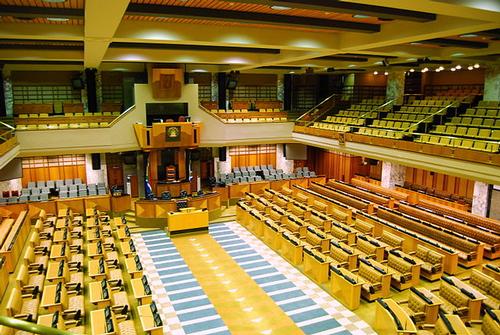 Meeting room of the National Assembly, South AfricaPhoto: Shi Zao CC 2.0 Unported no changes made
Meeting room of the National Assembly, South AfricaPhoto: Shi Zao CC 2.0 Unported no changes made
Administrative division
South Africa is divided into nine provinces according to the new constitution. For the current political situation see chapter history.
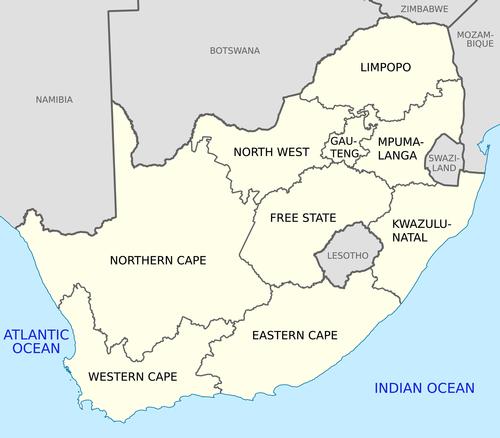 Provinces of South AfricaPhoto: Htonl CC 3.0 Unported no changes made
Provinces of South AfricaPhoto: Htonl CC 3.0 Unported no changes made
Education
Education among the black population was also severely affected by the apartheid regime. In 1953, the "Bantu Education Act" further restricted education for blacks, and mission education was also taken over entirely by the state. The government also determined education policy in terms of content and facilities. For example, education could only be taught in one's own language and the level was deliberately kept low.
In 1959, students were only allowed to go to a university of their own "color". Studying at the large "white" universities such as the University of Cape Town and that of Witwatersrand was excluded for colored people and blacks. Only In 1986, all races were in principle allowed to universities. This situation remained the same until 1990 and, for example, compulsory education for blacks was only arranged in 1991. For whites, compulsory education started in 1953, for Asians in 1979 and for colored people in 1980. However, black schools were struggling from the beginning with poor buildings, poor teaching materials, far too large classes, too small budgets. Illiteracy among the black population was very high. In 1985, 68% of the black population was unable to read or write against 7% of the white population. In 1990, only 36% of black students graduated from 90% of whites, colored people and Asians.
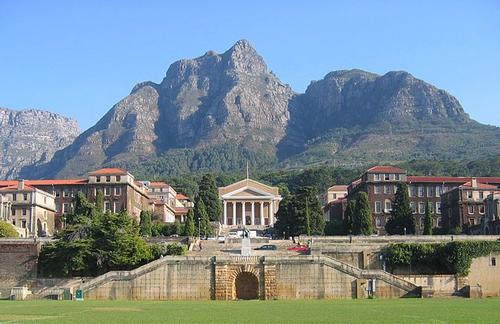 University of Cape Town, oldest university of South AfricaPhoto: Adrian Frith CC 3.0 Unported no changes made
University of Cape Town, oldest university of South AfricaPhoto: Adrian Frith CC 3.0 Unported no changes made
At present, the government is naturally striving for an integrated school system that should in principle be accessible to everyone. It will be clear that it is still far from ideal in practice. There will still be many cultural and psychological barriers to be overcome before really everyone has equal opportunities. In particular, the organization of education in the black townships, on which the majority of black children are dependent, is getting off to a slow start. In 1999, less than half of black secondary school students passed their final exams.
The Mandela government prepared the "Curriculum 2005", an attempt to solve most of the problems in education in 2005. Independent thinking and more harmonization of education on the labor market are central to this ambitious plan. People are also obliged to follow African and English in addition to education in their own (black) language. Strong emphasis is also placed on adult education, further training and written education. Whether this plan will be realized, however, remains to be seen, especially in view of the inadequate infrastructure of education.
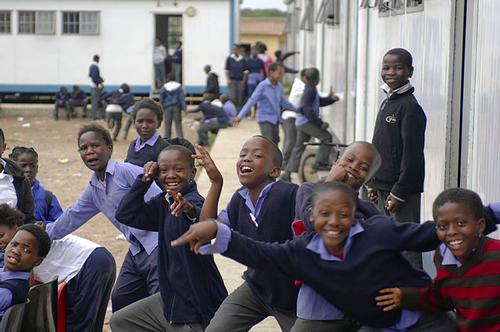 Students of the Lukhanyo Primary School, Zwelihle Township of Hermanus, Western Cape provincie, South AfricaPhoto: Andrew Shiva / Wikipedia / CC BY-SA 4.0 no changes made
Students of the Lukhanyo Primary School, Zwelihle Township of Hermanus, Western Cape provincie, South AfricaPhoto: Andrew Shiva / Wikipedia / CC BY-SA 4.0 no changes made
Apartheid
The Republic of South Africa has a wide variety of traditions, peoples and cultures. The white minority of the population has always held a dominant position in the economic, political and military spheres. This has created a society model since 1928 that has become internationally known as "apartheid". According to this ideology, all sections of the population were entitled to "a separate and distinct development towards independence"; in practice, however, the blacks could only develop if the whites were not affected and their position was not affected.
After years of resistance by legal organizations such as unions and churches, underground liberation movements and international pressure through mainly economic sanctions, the government has gradually parted ways with apartheid ideology and, in part, with the practice of apartheid, although this is not always evident. South Africa is still marked by the apartheid policy of yesteryear, for example in infrastructure, in the media, in street names, in education and in monuments. Submission and delusions of superiority still proliferate under the skin.
The population was divided into racial groups during the time of apartheid: whites, blacks, so-called "colored people" and Indians. This classification was very arbitrary because, for example, the Japanese population was counted among the whites and no distinction was made between whites of British, Dutch, French or German origin, for example. Black South Africans, on the other hand, were further classified by the government, which made a distinction between, among others, Xhosa, Zulu, Sotho, Tswana, Venda, Tsonga, Swazi and Ndebele.
In 1991, the Population Registration Act (1950) was repealed, the cornerstone of the apartheid system. Under this law, all South Africans were racially classified. Therefore, South Africans born after June 1991 no longer needed to be registered by race.
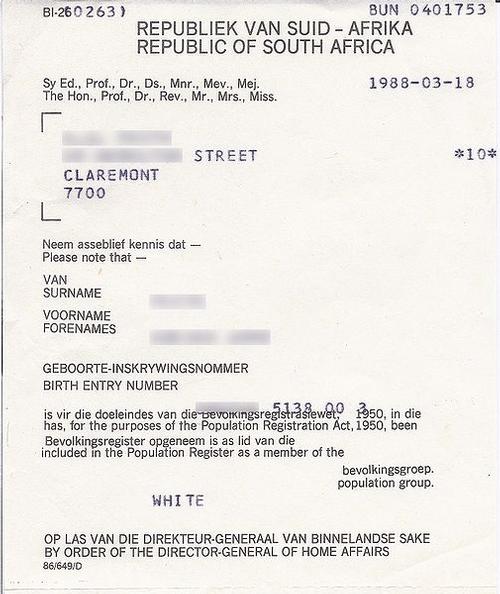 Example of a form of the racist Population Registration Act, South AfricaPhoto: Government of South Africa in the public domain
Example of a form of the racist Population Registration Act, South AfricaPhoto: Government of South Africa in the public domain
Sources
Dekker, M. / Zuid-Afrika
Gottmer/Becht
Luirink, B. / Zuid-Afrika : mensen, politiek, economie, cultuur, milieu
Koninklijk Instituut voor de Tropen,
Moerkamp, J. / Zuid-Afrika
ANWB
Schaap, D. / Zuid-Afrika
Minbuza Kosmos-Z&K
Zuid-Afrika
Cambium
CIA - World Factbook
BBC - Country Profiles
Last updated November 2025Copyright: Team The World of Info